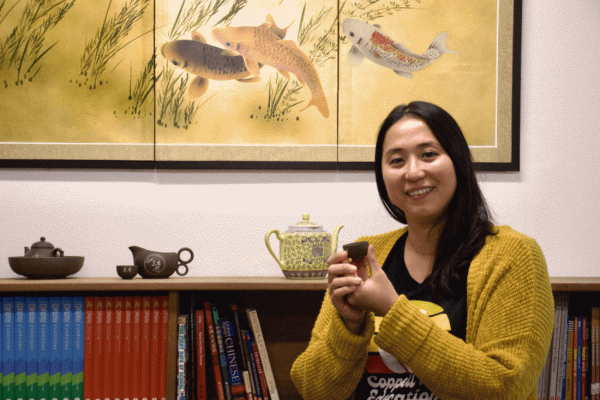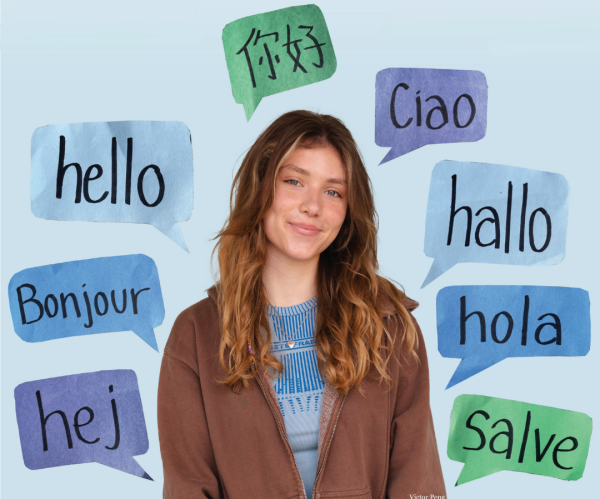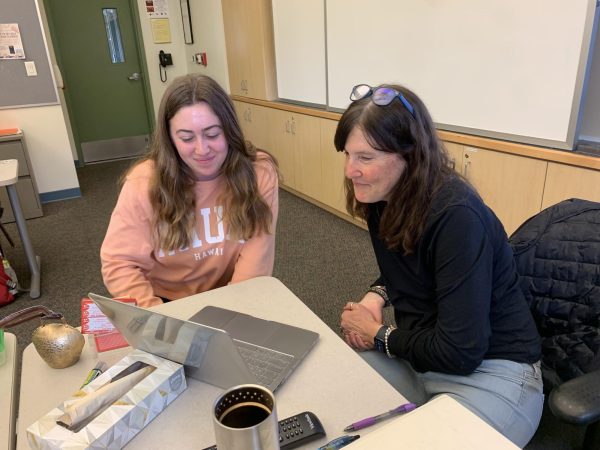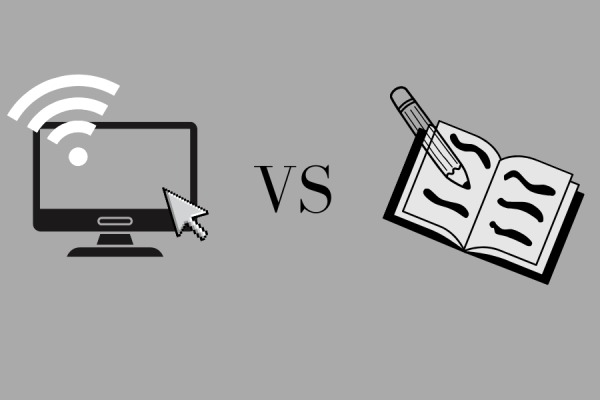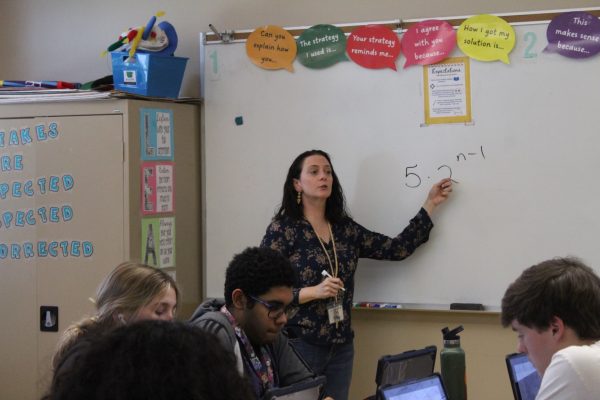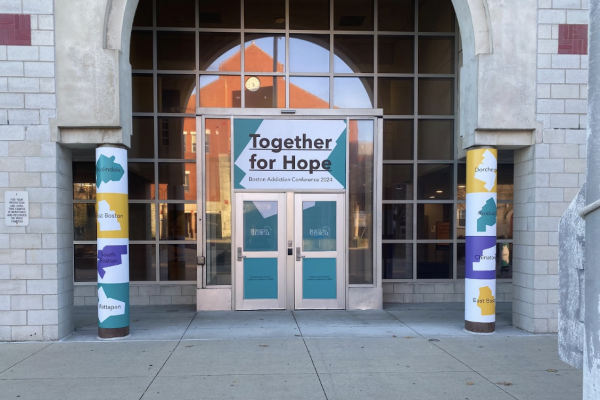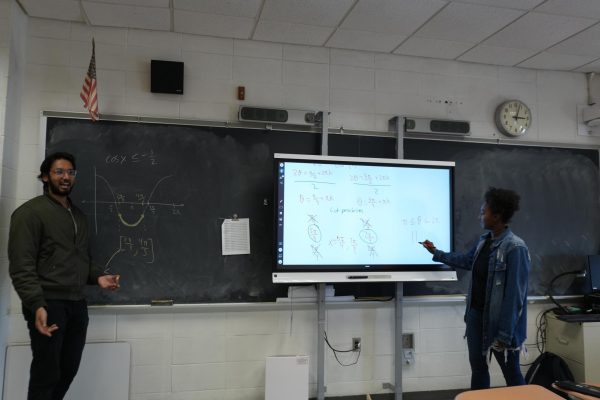The invisible battle
3 students share their experiences of schooling during COVID-19
November 3, 2020
Students worldwide are suffering the consequences of COVID-19 every day they go, or don’t go, to school. No matter the situation, each student is struggling in one way or another. Three students under particularly interesting circumstances share their stories, their invisible battles, of schooling during COVID-19.
Nefeli Tsangaropoulos
In the Bay Area, COVID-19 plays a massive role in everyone’s lives. From sanitizing ones hands everytime they get in the car to washing their masks, the COVID-19 routine has become a daily occurence. Nearly every school is shut down, following the remote learning plan, and Carlmont High School in Belmont, California, is no exception. Nefeli Tsangaropoulos, a junior at the school, struggles with anxiety, Attention Deficit Hyperactivity Disorder (ADHD), and depression.
COVID-19 is kind of downplayed in the Bay Area through the teens’ perspective. Although people still follow common protocol, the younger generation(s) tend to ignore it and still go out with large groups of friends with no masks and engage in physical contact.”
— Nefeli Tsangaropoulos
Tsangaropoulos has always had mental health issues, but starting high school made them escalate. Although not every year has been bad, this past summer and current fall semester with COVID-19 has brought a difficult journey.
In the beginning, COVID-19 didn’t take a significant toll on Tsangaropoulos. As for most students, it seemed like a small disturbance in life that would soon fade away.
“At first, in March, it wasn’t too bad. The main issue was staying on track and not procrastinating, and teachers were more laid back because it was new to everyone,” Tsangaropoulos said.
However, as time went on, the issues started to get worse. Similar to most self-diagnosing students, mental health was an important issue during the summer of the pandemic.
“Over the summer, I felt that I had no motivation to see friends or go outside. I went through about three major depressive episodes throughout COVID-19, two of which were over the summer. Once school started again, it was less overwhelming because the school had a more organized plan, although teachers still assign large amounts of homework,” Tsangaropoulos said.
During school, the effects of her depression are not as significant as her anxiety and ADHD. People with anxiety and ADHD commonly have trouble focusing on a single task, sitting still for long periods, or being calm for specific tasks. Unfortunately, classes over Zoom can heighten the tension for a person already managing anxiety or ADHD.
“As the first quarter continued, I found that I struggled a lot with keeping track of assignments, which brought up my anxiety. Another big issue for me is with Zoom because teachers make cameras mandatory, and having ADHD, I fidget and move around a lot. Being on camera is already something that brings up my anxiety, but having to stay completely still during Zoom classes ultimately brings it up even higher,” Tsangaropoulos said.
During the beginning of the pandemic, Tsangaropoulos’ family life had the most significant effect. It limited work for her mom, and the family of 5 felt as if they were spending too much time together. Although many have seen this time as an opportunity to bond, others have felt as if the pandemic brought more harm rather than benefit.
“At this time, I would say it has mostly mentally affected me in many good and bad ways. I have been able to educate myself on many political issues that I had ignored in the past, and it has helped me grow into a more open-minded person as well,” Tsangaropoulos said.
Unlike most students, Tsangaropoulos sees little benefit to going back to school. Although they have been rough, she feels that these past few months have been a great way to get back on track and learn new things.
“I wouldn’t like to go back to school completely because I think even though COVID-19 has brought many challenges, it has helped me become more independent and aware of important issues; something it has probably brought for others as well,” Tsangaropoulos said.
This journey has been a tough one for Tsangaropoulos and others in her situation, but things are starting to look up, and only for the better.
“Even though people haven’t been motivated in these hard times, it’s good to see friends and get outside. I’m very happy that water polo has started conditioning because it helps me feel healthy, both physically and mentally. It also is nice to see some of my teammates three times a week,” Tsangaropoulos said.
Lily Utt
At Shawnee Mission East High School in Prairie Village, Kansas, the students follow what some may know as the hybrid model. Those with the last names A-Lamb attend in-person schooling on Mondays and Tuesdays, while students with last names Lamc-Z go on Wednesdays and Thursdays. All students remain remote on Fridays.
At the beginning of the year, the students were given a chance to decide whether they wished to be fully online or opt into in-person learning for the fall semester. All students who choose online learning remain completely remote until they are given the ability to alter their response, if desired, at the start of the spring semester.
However, Lily Utt has a different story. At the age of nine, Utt was diagnosed with Common Variable Immune Deficiency (CVID).
“In simple terms, this means my body lacks a functioning immune system and any defense against the world’s bacteria and viruses,” Utt said. “Despite being vaccinated multiple times, my body does not know how to develop proper antibodies to fight off diseases. Because of this, I get sick much easier and much worse than the average person and am usually overly tired due to all my extra energy being used to fight off possible illness.”
CVID is, as some may say, an “invisible disorder” because of how little it affects Utt’s external appearance. She even says people can’t tell when they first meet her and think of her as just another student with a busy schedule. Due to this, many fail to regard Utt’s disorder when questioning her attendance, specifically at school.
“Most people have no idea I am sick when they meet me. I have a packed schedule of all AP classes, theater involvement, choir, tutoring, clubs, volunteer work, an internship, and forensics. The invisibility of my disease has led many people to be inconsiderate of my semi-frequent absence to school or my inability to constantly go,” Utt said.
The life-long disorder causes Utt to have to take action, receiving medication, and monthly plasma infusions.
“To combat CVID, I receive a monthly multi-hour infusion of plasma, essentially filled with someone else’s immune system. This is a temporary solution to a life-long problem, and I will be receiving these infusions for the rest of my life,” Utt said.
For Utt, COVID-19 has brought a restriction to her life she never knew would be set in place. She sits at home while her fellow students disregard the pandemic almor entirely and are out with friends and at parties.
“When I look on social media, I see most teenagers my age out with their friends, going to parties, and not following CDC guidelines. Most people have taken the stance of disregarding the pandemic entirely and carrying on with life as usual,” Utt said.
In her situation, Utt must have little contact with the outside world. She must be especially cautious with whom she meets, what she’s touched, and so much more. She is at such high risk that she’s pretty much spent the last eight months just sitting at home with her supportive family.
“As per the instructions of my doctor, I cannot see anyone who is going out regularly. Even wearing a mask and staying six feet apart poses a risk, so I have to avoid most contact with the outside world. This means I can’t hang out with my friends, go out to eat, or even see most of my family,” Utt said. “The most exciting thing in my life right now is the drive-thru for coffee where I wear a mask, gloves and disinfect my cup before touching it.”
I think some people forget this is an instance of life and death for other families with high-risk individuals and me. If I have to pick missing a year of my social life or losing my future, I will pick staying inside every time.
— Lily Utt
Thankfully, Utt has a close friend who also suffers from a chronic illness, placing her in what’s commonly known as the high-risk category and stopping her from going to school. Their families meet up regularly to keep each other’s spirits up and to keep connections.
Although Utt’s situation is not ideal, she believes that the hybrid model is overall both dangerous and ineffective. The students that go to school two times a week have an education program that is continuously altered. In contrast, Utt has understood how to learn in her solidified learning situation best, entirely at home.
“I think the hybrid model is ineffective as the in-person students are only receiving 90 minutes of direct instruction from their teacher per week. As a remote learner, I still meet with my teachers via WebEx three times a week, and I will probably be gaining more valuable time for learning or asking questions,” Utt said.
Further, Utt has an even smaller chance to experience her final year as a high schooler as a senior. Every party she sees on social media represents another month of quarantine for her; every time students go to school represents more time in quarantine. Everything going on around her symbolizes more time at home, alone.

“It is really hard to be experiencing this during my senior year. I cannot go to any of my final school dances, hang out with my friends I have had for years, go on college tours, or experience my extracurriculars to their fullest extent as I have always dreamed of. Senior year is a time in life people claim to be the most fantastic and exciting time ever, but instead of seeing the fun, I am inside alone,” Utt said.
Yet, although this has been a rough ride for Utt and her family, she understands that what she’s doing protects not only her, but those around her as well. As a high-risk individual, Utt truly understands what it’s like to be scared of going outside; something many others would not be able to get.
“While it is hard, I am proud of myself for making the safe decision not only for myself but for my community and being a part of the solution to the pandemic,” Utt said.
Meghan Cotton
Meghan Cotton has possibly one of the most interesting stories yet. The high school junior attends an international boarding school in the U.K., but she’s been going for longer than initially expected. Cotton currently resides and attends school in the south of England, just a few miles outside London.
Ever since starting her experience abroad, Cotton has loved it. She sees that attending an international school has allowed her to expand her horizons and understand others better. She is exposed to hundreds of different people and thinks it has benefitted her to becoming a better person today.
“An international boarding school is pretty different from a regular school, but in the best ways. I have spent lots of time learning about other cultures and how to live in a global community. It’s fascinating learning about other culture’s foods, customs, holidays, and history from people my age, so it’s cool, and I’m fortunate to be able to experience that,” Cotton said.
Yet, although Cotton loves attending school out of the country, plans didn’t quite go as expected this year. She was supposed to only attend schooling in Surrey for her sophomore year of high school; however, once COVID-19 hit, both she and her family believed the best choice to pursue at the time was to continue in the U.K.
“I came to the U.K. last year, expecting only to do a year abroad, have an amazing experience, and then come back to California for my junior year and stay there for the rest of high school. However, because of COVID-19, I ended up coming back to England. This happened for many reasons, one of which being that my family and I decided it would be best for both my mental and physical safety,” Cotton said.
When first arriving in England, cases weren’t nearly as bad as those in other countries. But, this is not to say these statistics were there to stay. Cotton’s final decision was based on the location in which she could attend schooling in person. That had turned out to be England.
“England had very few cases compared to the thousands California had, despite England being double the population of California, and we knew that I could get an in-person education here, rather than being online in California,” Cotton said.
Cotton’s decision turned out to be beneficial for her, and she now continues education in England for the 2020-2021 school year. Cotton believes that her viewpoint of COVID-19 and how the world has handled it has expanded because of her location and connections with people across the globe.
“During COVID-19, I also get a more worldly view of what’s happening with COVID-19 and where. In a way, it helps to know that this is happening everywhere because, to me, it helps to know the U.S. or the U.K. are not alone in this, but it also has the reverse effect because this virus is affecting so many different countries and at different rates!” Cotton said.
While the numbers weren’t as high in the U.K., the school still took the initiative to protect its students as much as possible. Each student has their temperature taken every morning and has been assigned concrete sitting locations during lunch and at classes.
“My school has both day and boarding students, so we have separate rules in school as we do in the boarding house. In the morning, we have our temperatures taken before we leave for school to make sure we’re healthy, and during school, we wear masks in the hall and the cafeteria, our desks are at least six feet apart, and we can only sit with three people at a table during lunch,” Cotton said.
In class, the students may only attend if there is enough space to distance themselves socially. If not, they must join by Zoom and learn via online means.
“We have different study hall rooms, cafeterias, and if you are taking a class with mainly people from another bubble, you have to join by Zoom if there is not enough space to physically distance yourself enough in the classroom,” Cotton said.
While there are both boarding and day students, the boarding students that live together stay together. They do not need to socially distance themselves from one another, but still need to remain cautious of others, including both day and boarding students.
“We also have different bubbles in school, so eleventh and twelve is divided into who is taking the IB course and who is taking the AP course, and we have to stay distanced within our bubbles, but even further distanced if we are with people from separate bubbles. In the boarding house, however, we are one bubble, so there is no distancing we have to do,” Cotton said.
And lastly, Cotton says that since the school is international, students visit their families worldwide. So, coming back to school is a big COVID-19 issue. If the country a student is returning from is in the “red zone,” they must quarantine for two weeks, attending school online before returning to regularly planned learning.
The pandemic has really altered a lot of aspects in my life, but I think it really changed how I see the world. Mentally, quarantine was very hard. I left England in March and did not attend a normal class until August.
— Meghan Cotton
Choosing the in-school option was a significant deciding factor for Cotton because she tends towards the side of needing to be in class to gain an enriching learning experience. It’s hard for her to gain a education while sitting at home, staring at a computer screen.
“Online learning is no easy feat, as most students know, but I also really struggle with motivation and focusing, and as my parents put it, I’m, ‘a kid who needs to be in a classroom and be with people.’ I really struggled not seeing people over the first quarantine, so coming back to England where I could not only be in-person and learning but in a boarding community with all my friends was the best option,” Cotton said.
Overall, COVID-19 has taken quite a significant toll on Cotton. Both at home and in the U.K., COVID-19 has shown Cotton the real value of life.
“It really did teach me how to appreciate things more, however, especially since we had a few family friends get COVID-19 and one even went onto a ventilator, so it taught me to appreciate life even further,” Cotton said.
Nonetheless, it does get complicated. Often, Cotton feels disconnected from her family and friends back in the states, and COVID-19 has not made this any easier.
More than just her family, COVID-19 has shown Cotton what life is like when you’re scared and alone. She understood what it was like to fear coming home as the borders were closing.
“In March, everybody left school within a weekend because we were all trying to get back into our countries before the borders closed. It was definitely one of the scariest weekends of my life because that’s when things felt real, and our boarding house of 65 went down to 32 in two days, and I had to get a flight home as soon as I could!” Cotton said.
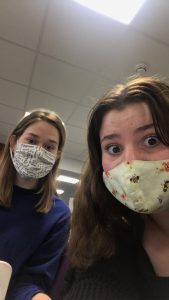
Lastly, Cotton finds that every aspect of her life has been altered due to COVID-19, holidays in particular. Spending time with one’s family is an important part of the holidays, and having to spend them alone for Cotton has been a painful issue, considering the connection between her and her family is very strong.
“It also gets tough during the holidays, where I want to be with my family back in California, but I can’t because a week and a half back home is almost not worth a two-week quarantine locked in a room at school,” Cotton said.
Final word
From the outside, schooling during COVID-19 may seem like a fun way to learn in bed and just let go. However, for many, this is truly a time of struggle. This experience is something like no other, and although we see each other through screens, we never understand what others are going through. Each student can hide behind the screen or hide their lives behind a virtual background, and viewers have no idea what invisible battle their classmates may be waging.
This story was originally published on The Forum on October 31, 2020.



























![IN THE SPOTLIGHT: Junior Zalie Mann performs “I Love to Cry at Weddings,” an ensemble piece from the fall musical Sweet Charity, to prospective students during the Fine Arts Showcase on Wednesday, Nov. 8. The showcase is a compilation of performances and demonstrations from each fine arts strand offered at McCallum. This show is put on so that prospective students can see if they are interested in joining an academy or major.
Sweet Charity originally ran the weekends of Sept. 28 and Oct. 8, but made a comeback for the Fine Arts Showcase.
“[Being at the front in the spotlight] is my favorite part of the whole dance, so I was super happy to be on stage performing and smiling at the audience,” Mann said.
Mann performed in both the musical theatre performance and dance excerpt “Ethereal,” a contemporary piece choreographed by the new dance director Terrance Carson, in the showcase. With also being a dance ambassador, Mann got to talk about what MAC dance is, her experience and answer any questions the aspiring arts majors and their parents may have.
Caption by Maya Tackett.](https://bestofsno.com/wp-content/uploads/2024/02/53321803427_47cd17fe70_o-1-1200x800.jpg)
![SPREADING THE JOY: Sophomore Chim Becker poses with sophomores Cozbi Sims and Lou Davidson while manning a table at the Hispanic Heritage treat day during lunch of Sept 28. Becker is a part of the students of color alliance, who put together the activity to raise money for their club.
“It [the stand] was really fun because McCallum has a lot of latino kids,” Becker said. “And I think it was nice that I could share the stuff that I usually just have at home with people who have never tried it before.”
Becker recognizes the importance of celebrating Hispanic heritage at Mac.
“I think its important to celebrate,” Becker said. “Because our culture is awesome and super cool, and everybody should be able to learn about other cultures of the world.”
Caption by JoJo Barnard.](https://bestofsno.com/wp-content/uploads/2024/01/53221601352_4127a81c41_o-1200x675.jpg)




